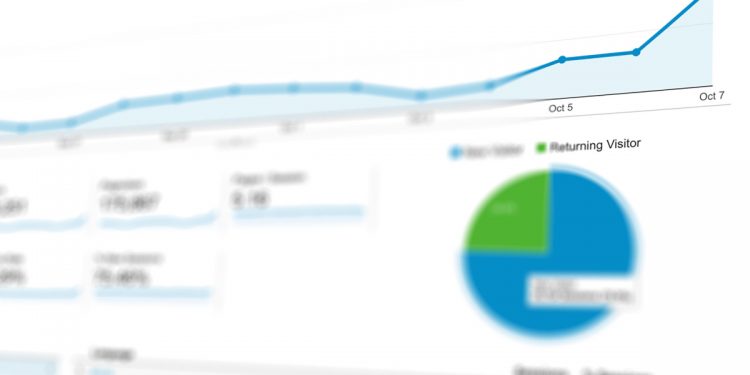
When it comes to building a sustainable, profitable e-commerce website, only one thing matters – sales.
See a spike in sales of your brand new products, and you would be happy all day long.
Watch the slump in total sales from your latest campaign and you will be downward frustrated.
When the latter happens, most small business owners will react by spending more money on advertising, fixing the pricing, changing the site layouts and so on.
This impetuous, aimless strategy wouldn’t come to fruition and eventually led to their business downfall.
Yes, the evidence is here – almost 65% of businesses fail in the first 18 months and 90% in the first years because of the lack of long-term marketing strategies to navigate the challenge of online business.
Sure, it would scare you a bit, but don’t worry. Today, we will reveal to you how analytics can improve your e-commerce sales.
What Is Analytics?
Analytics is the process of measuring site statistics to drive continual improvement of the online experience your customers have which translates to your desired outcomes.
It provides the relevant information you can use to improve your business.
As an e-commerce business owner, your desired outcome should be increasing the sales of your product.
If your site has gained significant numbers of visitors and buyers, it is advisable to use analytics software to collect the data and analyse.
The most popular tool you can use is Google Analytics.
It’s free and a simple analytic tool that you can install to your e-commerce site. You can access it from here.
How Analytics Can Make You More Money?
1. It helps you understand what’s wrong about your sales performance
Sometimes, the sale of the product is not influenced by the market sentiment, offer or any other external contributors, but customer behaviour.
With analytics, you can get a bigger picture of how customers use your website.
For example, analytics can reveal the significant number of drop-offs at the checkout page.
You would notice the high percentage of customers who don’t complete the buying process, resulting in lower sales on the checkout.
You can use this insight to optimise your checkout page so you can reduce shopping cart abandonment rate and improve your sales.
2. It assists you optimising the e-commerce site
Once you have carefully studied the actions of your visitors or web users, you are able to act accordingly in order to optimise your website.
You will have an idea about the things that need changing and the aspects of your website that may appeal more to your market.
Furthermore, you will know which products are most viewed and which are ignored.
By understanding the data, you can make adjustments to certain aspects of your website.
For example, you could change the headline and the text on the homepage, editing product descriptions to match with products and brand, the placement of a call-to-action button on the checkout page and resizing the product images to make them bigger.
You could then fix any technical problems; or you could also improve, streamline or reshape site navigation to better assist your site users or visitors.
3. It helps you formulate sales and digital marketing plan
Web analytics can assist you in preparing for an online marketing plan and course of action.
This is effective because your plan would be based on actual facts and not mere assumptions. You now know what your customers want.
By tracking items that are highly viewed on your website, you understand which products your customers are looking for.
This gives you an insight for your next paid advertising campaigns;
How much you should spend on ads?
Which top products to be advertised for Facebook Ads’ performance marketing campaign?
What keywords to be added to the existing Google Ads campaigns?
Your digital marketing plan will run perfectly brilliant once you gather the information from Google Analytics.
How To Set Up Google Analytics For E-commerce Site
1. Overview
Now you have a better understanding of how analytics can boost your e-commerce sales.
So, the next step you should do is setting up analytics for your e-commerce site.
For this setup, you can use Google Analytics. You can access it by signing in with your Google account.
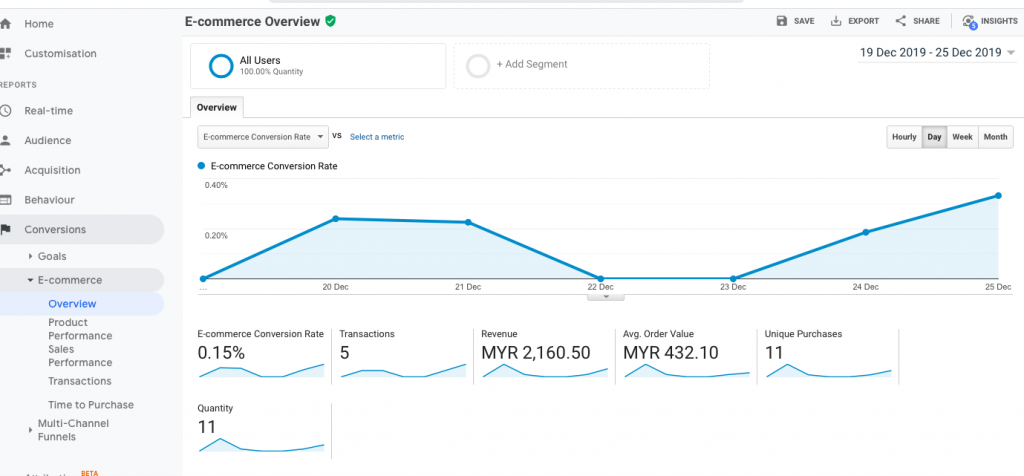
Follow the steps required for the setup.
Make sure to add the Google Analytics tracking code to your store so Google will start tracking traffic.

After everything is set up correctly, you’ll start seeing data in your reporting tab.
This is where all the process happens so let’s get familiar with it.
Besides information on the Audience of your website’s visitors, Google Analytics uses Acquisition, Behavior and Conversions, which describes the customer journey as visitors move through your e-commerce store and make purchases.
You’ll find these sections in the Reporting tab.
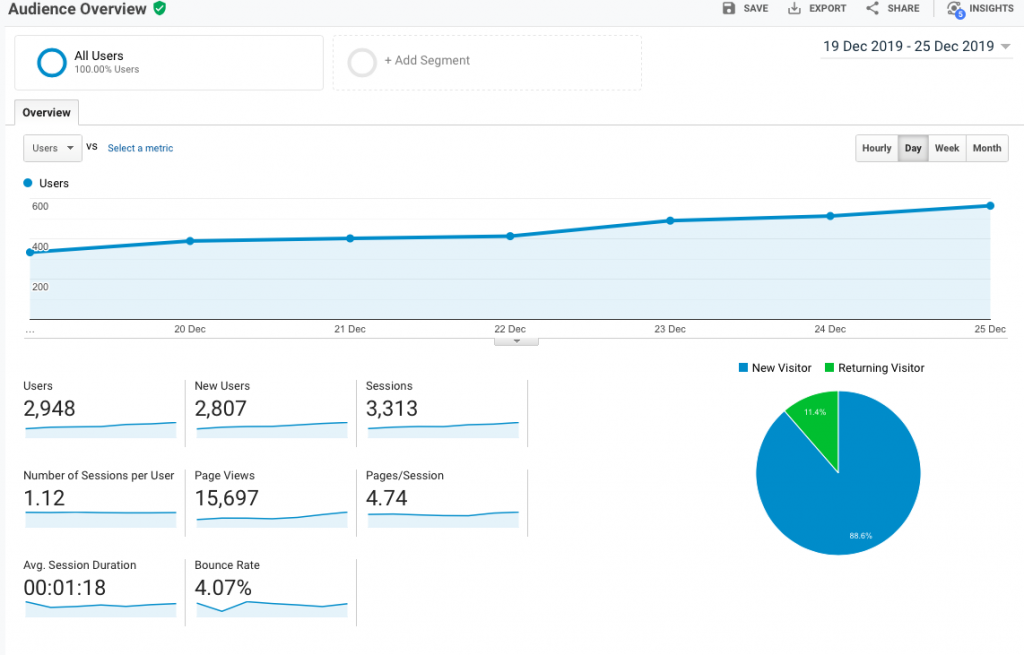
2. Set up your goal
The main goal of e-commerce analytics is making a sale.
Every time a visitor makes a purchase, it counts as a completed goal and shows up in your analytics reports.
To start, click on the admin tab in the main menu at the top of the page.
On the right-hand side, you should see the ‘Goals’ sub-menu. Click on ‘Goals’.
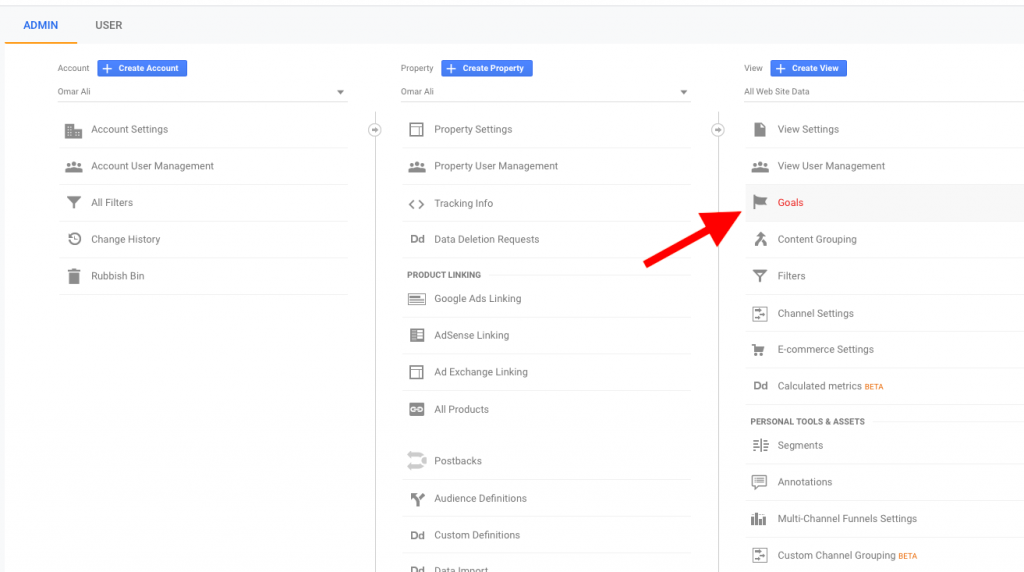
3. Create a New Goal and Goal Setup
Click on the red ‘+ New Goal’ button.
Select a template and then select ‘Place an order’ on the drop-down menu. Now click the blue ‘Next step’ button.
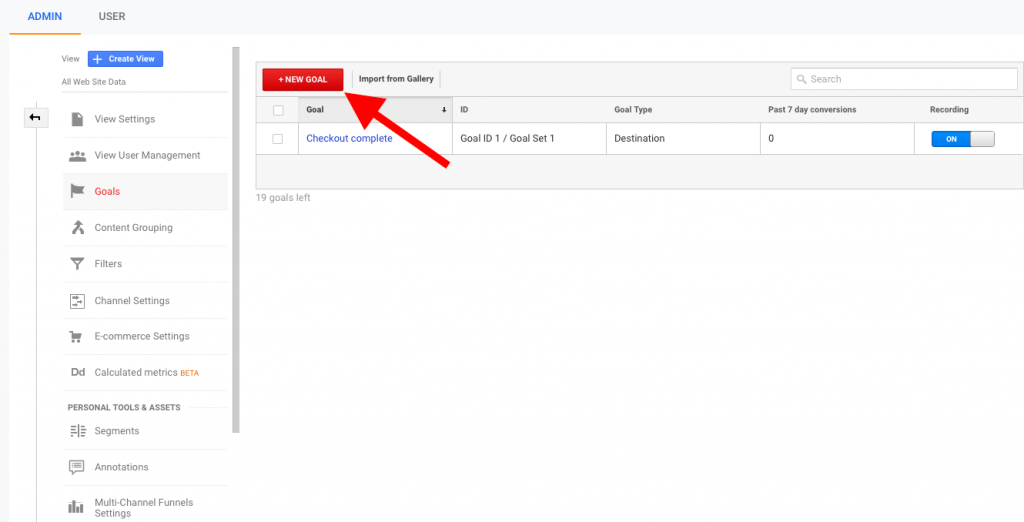
4. Goal Description
Next up, name your goal. You can add goal such as Place an Order, Purchase or use templates given. Leave it checked as ‘Destination’ under type.
Now click the blue ‘Next step’ button to continue.
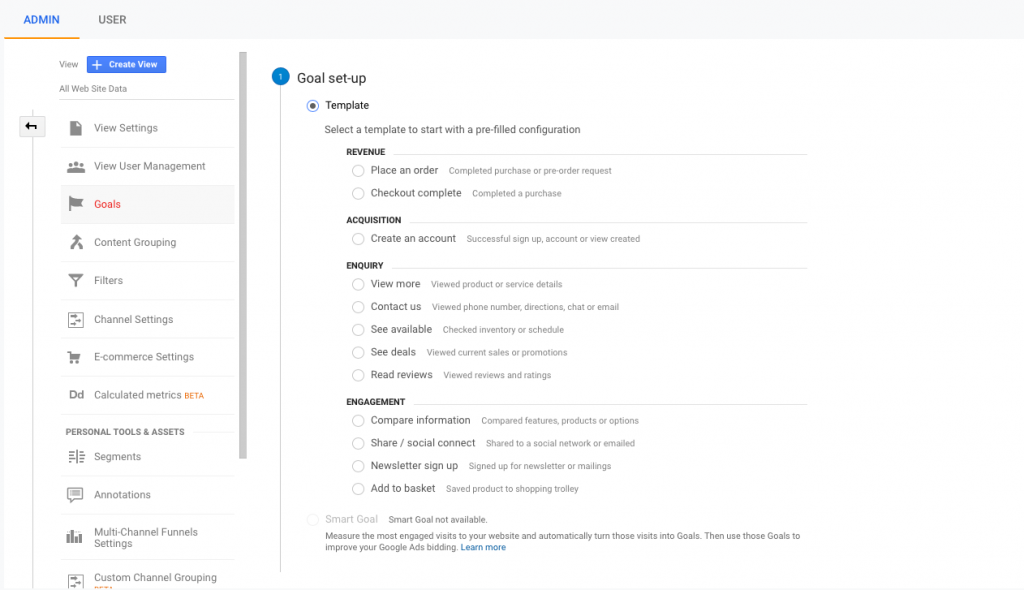
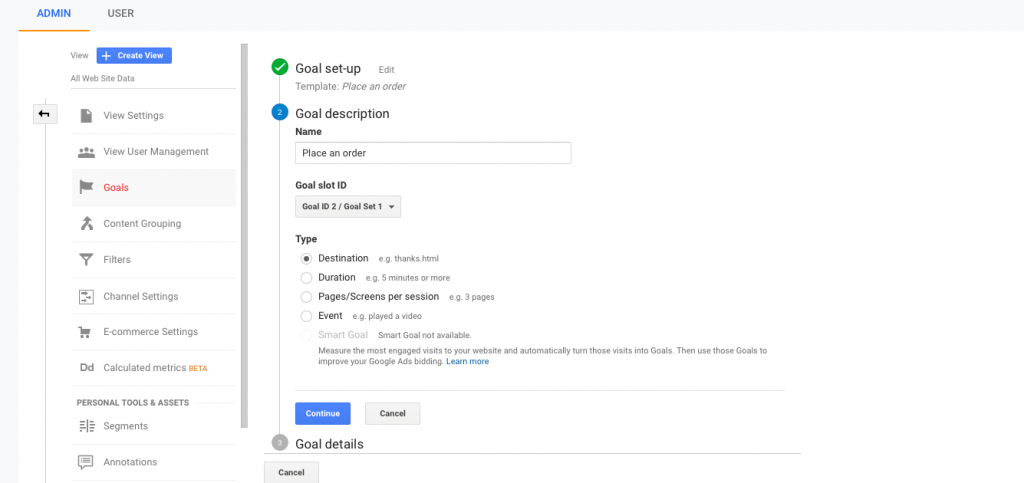
5. Goal Details
The final step is to define the URL of the thank you page.
This setting is crucial because it will show you exactly whether visitors are completing the purchase or not on your e-commerce site.
Most e-commerce platforms’ thank you page has ’/checkout/thank_you’ as seen below. Leave the monetary value turned off. Turn the funnel optional switch to ‘On’.
Now you must list the pages and their respective URL that your visitor goes through during your checkout process.
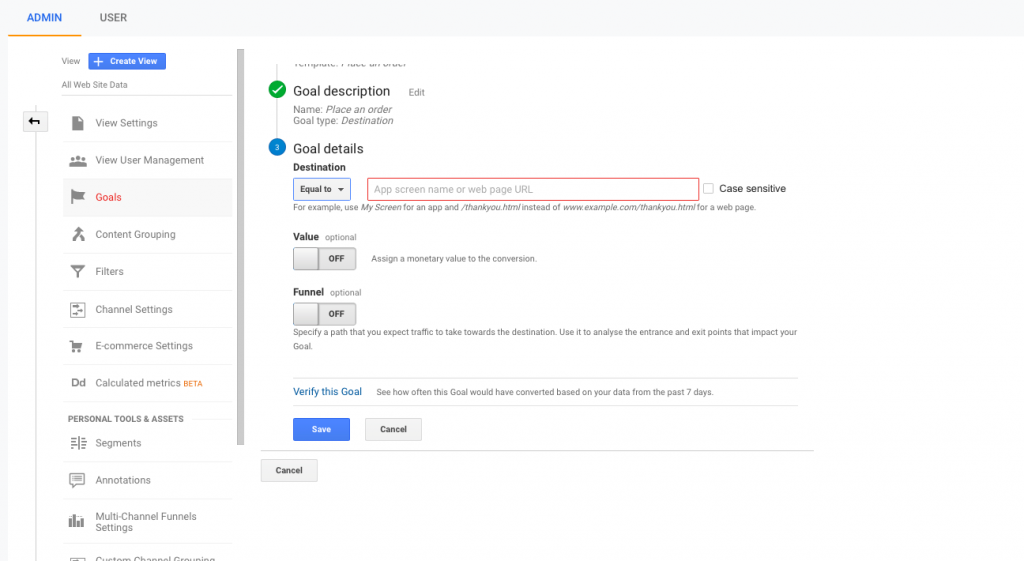
6. Verify Goal
Once you’ve completed all the relevant steps, click ‘Verify this Goal’.
Make sure the percentage is more than 0% (unless your store is brand new and had no sales yet) so you know you got the destination URL correct.
Now you’ll start seeing conversion data for your reports.
Get Insights Quickly With Google Analytics Dashboards for E-commerce
There’s a vast amount of data available in Google Analytics you can explore.
For e-commerce sites, the data generated by Google Analytics are huge and can be daunting, especially accessing the key metrics at a glance.
The solution – Google Analytics Dashboards for E-commerce. It is a great way to get an instant overview of what’s happening in your e-commerce site.
The format of dashboards is report summaries comprising of a maximum of 12 widgets (boxes), at a maximum of 10 rows per widget.
Each Google Analytics account has an allowance of 20 dashboards.
There are custom dashboards you can explore from some of the e-commerce experts. Here is the snippet from one of the dashboards:
All-in-one E-commerce Dashboard, by Paolo Margari
“This report utilizes the 12-widget dashboard limit with some of the most important e-commerce transaction metrics. The big, colorful bar chart labeled “Ecommerce Conversion Rate by Medium and Device Category,” details the conversion rate of each device type, broken down by desktop, mobile and tablet. There is a “Transaction by Medium” pie chart that details the top six sales referral channels.
There are also corresponding tables for the graphs mentioned above as well as standard e-commerce metrics, such as transactions, conversion rates, and revenue. The other widget worth mentioning is the “Transaction and Ecommerce Conversion Rate by City” report that details transactions and conversion rates by city.”
Final note
Using analytics offer some incredibly useful features for your e-commerce site.
With the data provided in Google Analytics and the insight you gain from that data, you will be able to steer your online business to success.
Have you used analytics for your e-commerce site? Let us know your experience in the comment below.

